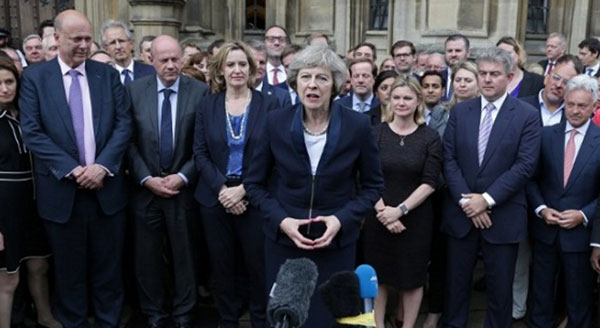
London, United Kingdom | AFP | An exit poll following Britain’s general election on Thursday suggested the country could be heading for a “hung parliament”, in which no party has an overall majority.
Here is what would happen next if the forecast is confirmed by the full results, most likely due on Friday.
– There are 650 seats in the House of Commons up for grabs at the election. One party needs to win at least 326 to secure an overall majority. The exit poll — which must be treated with caution given the poor reliability of forecasts in recent British elections — indicates the Conservatives have won 314, Labour 266, the Scottish Nationalists 34 and the Liberal Democrats 14.
– If this does translate into a hung parliament when results come through, Theresa May as incumbent prime minister will have the first shot at trying to form a government — either as a minority or in coalition with others.
– If May did manage to do this, she would then go to the House of Commons to see if her government could survive a motion of confidence, probably after the state opening of parliament on June 19.
– But if May could not form a government or did not survive the motion of confidence, she would be expected to hand in her resignation to Queen Elizabeth II.
– The monarch would then be likely to invite Jeremy Corbyn, leader of the main opposition Labour party, to try to form a government. That, again, could be a minority or coalition administration.
– If no government can command the confidence of the House of Commons, parliament can be dissolved and another election held.
Britain’s first-past-the-post voting system means hung parliaments are relatively rare — there have been only five since the end of the 19th century.
The last ones were:
May 2010
Prime Minister: David Cameron (Conservatives)
Composition: Conservative-Liberal Democrat coalition
Lasted: Five years
February 1974
Prime Minister: Harold Wilson (Labour)
Composition: Labour minority government
Lasted: Eight months
1929
Prime Minister: Ramsey MacDonald (Labour)
Composition: Minority Labour government backed by Liberals
Lasted: until 1931, but amid the Great Depression, MacDonald formed ‘National’ coalition government of Conservatives, Liberals and small number of Labour MPs which won 1931 and 1935 elections.
1923
Prime Minister: Ramsey MacDonald (Labour)
Composition: Prime Minister Stanley Baldwin’s Conservatives won more seats than Labour but stepped aside for Labour’s MacDonald
Lasted: 10 months
1910
Prime Minister: Herbert Asquith (Liberal Party)
Composition: Liberal Party in a minority government, with support of Labour and the Irish Nationalists. Then a coalition government from 1915.
Lasted: Six years
 The Independent Uganda: You get the Truth we Pay the Price
The Independent Uganda: You get the Truth we Pay the Price


